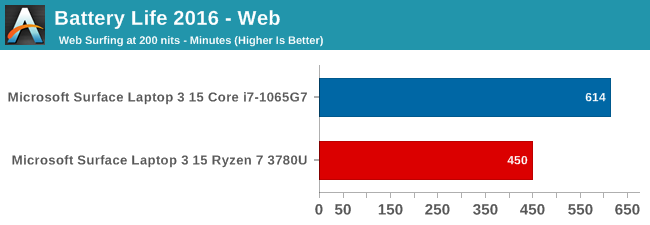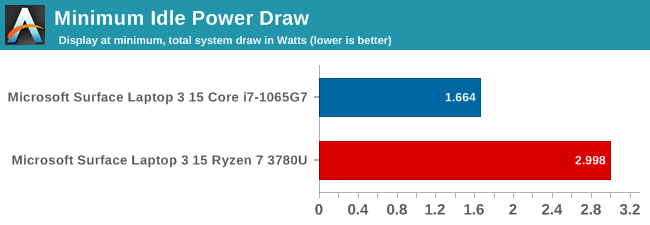The Microsoft Surface Laptop 3 Showdown: AMD's Ryzen Picasso vs. Intel's Ice Lake
by Brett Howse & Andrei Frumusanu on December 13, 2019 8:30 AM ESTPlatform Power
Performance aside, the other side of the coin is battery life. AMD made big gains in battery life with the Ryzen 3000 series, somewhat addressing the power requirements of the platform and getting rid of some of the excessive idle power draw, but they are still using DDR4 on their mobile platform, which puts them at a disadvantage right out of the gate. Intel has made very good gains in battery life over the last several generations, and the move to 10 nm for Ice Lake also brought along LPDDR4X support. Most of the previous generation laptops stuck with LPDDR3, unless the manufacturer needed more than 16 GB of RAM, where they’d be forced to switch to DDR4. Finally adding LPDDR4X support is something that Intel has needed to do for a while, and ironically Intel’s flagship Core product line lagged behind their low-cost Atom lineup which did support LPDDR4.
Web Battery Life

The Ryzen 7 3780U powered Surface Laptop 3 was slightly under the Ryzen 5 device we tested at launch, but still in the same range. The AMD system isn’t helped very much by Microsoft only offering a 46 Wh nominal battery capacity, which is rather undersized for a 15-inch laptop. The Ice Lake device, as we’ve seen before, was much more efficient under load, offering a sizeable battery life lead.
Idle Power
One of AMD’s biggest challenges was to get their laptop SoC into a premium device, and with the Surface Laptop 3 they have succeeded. Microsoft has shown themselves as being adept at squeezing battery life out of devices, with low-power displays, and good internal components to minimize power draw. Here Intel has held a considerable advantage over the last couple of years, and the move to 10 nm should, in theory, help as well.
To test the idle power draw of both systems, the battery discharge rate was monitored with the screens fixed in at 5.35 nits, to minimize the power draw of the display on the result. Normally we’d prefer to have the display completely off for this test, but Microsoft’s power plan on the Surface Laptop actively turns off the laptop when the display times out.

The Ice Lake system was able to go all the way down to right around 2 Watts of power draw – and sometimes slightly under – with as low as 1.7 Watts seen. We’ve seen under 1 Watt of draw on an 8th generation Core Y series processor, and around 1.5 Watts on the same generation U series, so considering the display is not completely off on the Surface Laptop, the 2-Watt draw is quite reasonable.
The Picasso system was not quite as efficient, drawing 3 Watts at idle. This is in-line with the results we’ve seen on other Picasso systems and explains the lower battery life results on the AMD system. AMD made big gains moving from Raven Ridge to Picasso, but I’m sure the team is looking forward to the 7 nm Zen 2 coming to their laptops, which we hope will address this further.










174 Comments
View All Comments
Cliff34 - Saturday, December 14, 2019 - link
I agree. AMD won't be able to compete w Intel until AMD focuses on building cpus for laptops.generalako - Monday, December 16, 2019 - link
Ehhh, Sunny Cove's successor will bring an equal IPC increase, from what Intel has stated.AMD has themselves to blame. Why tf would you delay the architecture of both GPU and CPU and process node as well like that? I mean, the money lost from doing that, as OEMs will have little reason to move away from Intel's superior products, outweighs the money "saved" from this delay, no? Not like a Zen 2 APU won't come anyway, so why not do it before rather than after?
If AMD are smart they'll jump one architecture ahead. Starting with Zen 4 in 1.5 year's time, they should be smart enough to jump straight from Zen 2 APU to Zen 4.
Korguz - Monday, December 16, 2019 - link
generalako " Ehhh, Sunny Cove's successor will bring an equal IPC increase, from what Intel has stated. " and you believe intel ???cheshirster - Tuesday, December 31, 2019 - link
"Sunny Cove's successor will bring an equal IPC increase, from what Intel has stated"They never stated that.
Qasar - Wednesday, January 1, 2020 - link
heh... yea right.. until its proven, just another lie from intel to keep their investors and shareholders happy....azazel1024 - Monday, December 16, 2019 - link
I don't think it is just the IPC boost. The two chips in the comparison here had memory bandwidth differences of 80%!Simply looking at a few of the SPEC INT tests, that was very clear that if AMD even on Zen had similar memory bandwidth to the Ice Lake chip, it likely would have been spitting distance. GPU workloads are also very heavily memory bandwidth constrained and AMD's Vega here was slightly ahead of Intel. If it had 80% higher memory bandwidth it probably would have been 20-30% faster in many of those games/benchmarks.
Even some of the not heavily memory constrained workloads like Handbrake, faster memory does improve performance. That 80% memory bandwidth difference may well have been a 5-8% performance hit to AMD.
BUT AMD shipped it with only DDR4-2400 support. It is the chip they brought to the fight.
If their Zen 2 manages to both have lower platform power (doesn't need to be parity with Intel or better, but 10% better would go a huge long way towards making it less of a decision for a lot of people), brings its 15% better IPC and if it keeps its clock speeds AND manages to bring DDR4L-3000/DDR4x-3760 or whatever compatibility and suspect Intel is done for in the laptop space.
That should give AMD several more wins in CPU performance, bring it to parity or near parity in most of the others leaving Intel with only a few wins in that. For GPU performance, AMD wouldn't even really need to update the iGPU. Just give it that extra bandwidth and Zen 2 CPU behind it and it likely would be kicking Intel's butt by 20-40%. Upgraded on top of having that, yes please.
qap - Saturday, December 14, 2019 - link
I don't think it is about IPC or CPU power anymore. Yes, AMD is slower, but not in a way that would bother me. It is more about power management that is and always was sore spot of AMD in notebooks.And no - 7nm is not the solution unfortunately. It may help under load, but under standby it can actually hurt battery life (leakage is higher). Most improvements in battery life are done by architectural changes (more specialized units, powering down unused parts etc).
nico_mach - Tuesday, December 17, 2019 - link
Well, this driver is still under development and in the first test, they were running cooler than Intel, so likely there is tuning to be done, still. They just haven't done much laptop work in recent years. They're going to be behind on more than the hardware, which is why Microsoft's involvement is really promising, really. Of course they still have some minor hardware matters to sort out, as you point out.Rezurecta - Friday, December 13, 2019 - link
Do you think a lot of help came from the sizeable memory speed differences? Do you think it benefitted cpu or gpu more? Is there a way to underclock the Intel memory so you can see the differences that the memory brings?Thank you.
ikjadoon - Friday, December 13, 2019 - link
It's perplexing: AMD created an entirely new SKU for Microsoft (the AMD RYZEN™ 7 3780U Microsoft Surface® Edition Processor), but AMD still left this CU 11-equipped iGPU at the barebones 2400 MHz speed.Why not rate this MS-only SKU at 2933MHz or 3200MHz? My only thought: high-speed DDR4 was just going to exacerbate AMD's already-too-large power consumption.